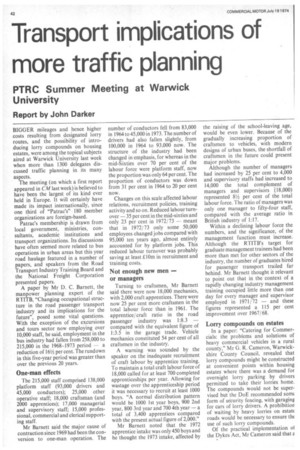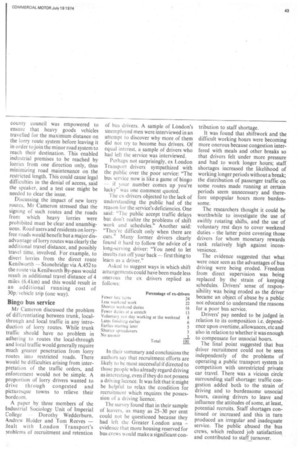Transport implications of more traffic planning
Page 44

Page 45

If you've noticed an error in this article please click here to report it so we can fix it.
PTRC Summer Meeting at Warwick University
Report by John Darker
BIGGER mileages and hence higher costs resulting from designated lorry routes, and the possibility of introducing lorry compounds on housing estates, were among the topical subjects aired at Warwick University last week when more than 1300 delegates discussed traffic planning in its many aspects.
The meeting (on which a first report appeared in CM last week) is believed to have been the largest of its kind ever held in Europe. It will certainly have made its impact internationally, since one third of "Patrac's" 180 member organizations are foreign-based.
Patrac's membership is drawn from local government, ministries, consultants, academic institutions and transport organizations. Its discussions have often seemed more related to bus operations in urban areas but this year road haulage featured in a number of papers, and speakers from the Road Transport Industry Training Board and the National Freight Corporation presented papers.
A paper by Mr D. C. Barnett, the manpower planning expert of the RTITB, "Changing occupational structure in the road passenger transport industry and its implications for the future", posed some vital questions. With the exception of the excursions and tours sector now employing over 10,000 staff, he said, employment in the bus industry had fallen from 258,000 to 215,000 in the 1968-1973 period — a reduction of 161/2 per cent. The rundown in this five-year period was greater than over the previous 20 years.
One-man effects
The 215,000 staff comprised 138,000 platform staff (93,000 drivers and 45,000 conductors); 25,000 other operative staff; 18,000 craftsman (and 2000 apprentices); 17,000 managerial and supervisory staff; 15,000 professional, commercial and clerical supporting staff.
Mr Barnett said the major cause of contraction since 1969 had been the conversion to one-man operation. The number of conductors fell from 83,000 in 1964 to 45,000 in 1973. The number of drivers had also fallen slightly, from 100,000 in 1964 to 93,000 now. The structure of the industry had been changed in emphasis, for whereas in the mid-Sixties over 70 per cent of the labour force were platform staff, now the proportion was only 64 percent. The proportion of conductors was down from 31 per cent in 1964 to 20 per cent now.
Changes on this scale affected labour relations, recruitment policies, training activity and so on. Reduced labour turnover — 35 per cent in the mid-sixties and only 23 per cent in 1972/73 -meant that in 1972/73 only some 50,000 employees changed jobs compared with 95,000 ten years ago, almost entirely accounted for by platform jobs. This reduced labour turnover was probably saving at least 10m in recruitment and training costs.
Not enough new men or managers
Turning to craftsmen, Mr Barnett said there were now 18,000 mechanics, with 2,000 craft apprentices. There were now 25 per cent more craftsmen in the total labour force than in 1961. The apprentice/ craft ratio in the road passenger industry was 1:8.3 — compared with the equivalent figure of 1:3.5 in the garage trade. Vehicle mechanics constituted 54 per cent of all craftsmen in the industry.
A warning was sounded by the speaker on the inadequate recruitment of craft labour by apprentice training. To maintain a total craft labour force of 18,000 called for at least 700 completed apprenticeships per year. Allowing for wastage over the apprenticeship period it was necessary to recruit at least 1000 boys. "A normal distribution pattern would be 1000 1st year boys, 900 2nd year, 800 3rd year and 700 4th year — a total of 3,400 apprentices compared with the present actual figure of 2,000."
Mr Barnett noted that the 1972 apprentice intake was only 450 boys and he thought the 1973 intake, affected by the raising of the school-leaving age, would be even lower. Because of the gradually increasing proportion of craftsmen to vehicles, with modern designs of urban buses, the shortfall of craftsmen in the future could present major problems.
Although the number of managers had increased by 25 per cent to 4,000 and supervisory staffs had increased to 14,000 the total complement of managers and supervisors (18,000) represented 81/2 per cent of the total labour force. The ratio of managers was only one manager to fifty-four staff, compared with the average ratio in British industry of 1:17.
Within a declining labour force the numbers, and the significance, of the management function must increase. Although the RT1TB's target for graduate management trainees had been more than met for other sectors of the industry, the number of graduates hired for passenger transport trailed far behind. Mr Barnett thought it relevant to point out that in the context of a rapidly changing industry management training occupied little more than one day for every manager and supervisor employed in 1971/72 — and these figures represented a 115 per cent improvement over 1967/68.
Lorry compounds on estates
In a paper: "Catering for Commercials: the problems and solutions of heavy commercial vehicles in a rural county," Mr G. R. Cameron, Warwickshire County Council, revealed that lorry compounds might be constructed at convenient points within housing estates where there was a demand for overnight lorry parking by drivers permitted to take their lorries home. The compounds would not be supervised but the DoE recommended som( form of se'curity fencing, with garaging for cars of lorry drivers. A prohibition of waiting by heavy lorries on estat( roads would be necessary to ensure th( use of such lorry compounds.
Of the practical implementation of the Dykes Act, Mr Cameron said that z county council was empowered to ensure that heavy goods vehicles travelled for the maximum distance on the lorry route system before leaving it in order to join the minor road system to reach their destination. This enabled industrial premises to be reached by lorries from one direction only, thus minimizing road maintenance on the restricted length. This could cause legal difficulties in the denial of access, said the speaker, and a test case might be needed to clear the issue.
Discussing the impact of new lorry routes, Mr Cameron stressed that the signing of such routes and the roads from which heavy lorries were prohibited must be clear and unambiguous. Road users and residents on lorryfree roads would benefit but a major disadvantage of lorry routes was clearly the additional travel distance, and possibly travel time, involved. For example, to divert lorries from the direct route Kenilworth — Stonebridge via A.452 to the route via Kenilworth By-pass would result in additional travel distance of 4 miles (6,4 km) and this would result in an additional running cost of 30p; vehicle trip (one way).
Bingo bus service
Mr Cameron discussed the problem of differentiating between trunk, localthrough and local traffic in any introduction of lorry routes. While trunk traffic should have no problem in adhering to routes the local-through and local traffic would generally require much greater penetration from lorry routes into restricted roads. There would be difficulties arising from interpretation of the traffic orders, and enforcement would not be simple. A proportion of lorry drivers wanted to drive through congested and picturesque towns to relieve their bordeom.
A paper by three members of the Industrial Sociology Unit of Imperial College -Dorothy Wedderburn, Andrew Holder and Tom Reeves — Jealt with London Transport's )roblems of recruitment and retention of bus drivers. A sample of London's unemployed men were interviewed in an attempt to discover why more of them did not try to become bus drivers. Of equal interest, a sample of drivers who had left the service was interviewed.
Perhaps not surprisingly, ex London Transport drivers sympathized with the public over the poor service: "The bus service now is like a game of bingo — if your number comes up you're lucky" was one comment quoted.
The ex-drivers objected to the lack of understanding the public had of the reason for the service's deficiencies. One said: "The public accept traffic delays but don't realize the problems of shift work and schedules." Another said: "They're difficult only when there are cuts," Many former drivers clearly found it hard to follow the advice of a long-serving driver: "You need to let insults run off your back — first thing to learn as a driver."
Asked to suggest ways in which shift arrangements could have been made less onerous the ex drivers replied as follows: In their summary and conclusions the authors say that recruitment efforts are likely to be most successful if directed to those people who already regard driving as interesting, even if they do not possess a driving licence. It was felt that it might be helpful to relax the condition for recruitment which requires the possession of a driving licence.
The survey found that in their sample of leavers, as many as 25-30 per cent could not be questioned because they had left the Greater London area evidence that more housing reserved for bus crews would make a significant con tribution to staff shortage.
It was found that shiftwork and the difficult working hours were becoming more onerous because congestion interfered with meals and other breaks so that drivers felt under more pressure and had to work longer hours; staff shortages increased the likelihood of working longer periods without a break; the distribution of passenger traffic on some routes made running at certain periods seem unnecessary and therefore unpopular hours more burdensome.
The researchers thought it could be worthwhile to investigate the use of swiftly rotating shifts, and the use of voluntary rest days to cover weekend duties the latter point covering those drivers for whom monetary rewards rank relatively high against inconvenience.
The evidence suggested that what were once seen as the advantages of bus driving were being eroded. Freedom from direct supervision was being replaced by the strain of keeping schedules. Drivers' sense of responsibility was being eroded as the driver became an object of abuse by a public not educated to understand the reasons for a poor bus service.
Drivers' pay needed to be judged in relation to its composition i.e. dependence upon overtime, allowances, etc and also in relation to whether it was enough to compensate for unsocial hours.
The final point suggested that bus driver recruitment could not be seen independently of the problems of operating a public transport system in competition with unrestricted private car travel. There was a vicious circle surrounding staff shortage: traffic congestion added both to the strain of driving and to burdensome unsocial hours, causing drivers to leave and influence the attitudes of some, at least, potential recruits. Staff shortages continued or increased and this in turn produced an irregular and inadequate service. The public abused the bus crews, which reduced job satisfaction and contributed to staff turnover.








































































































